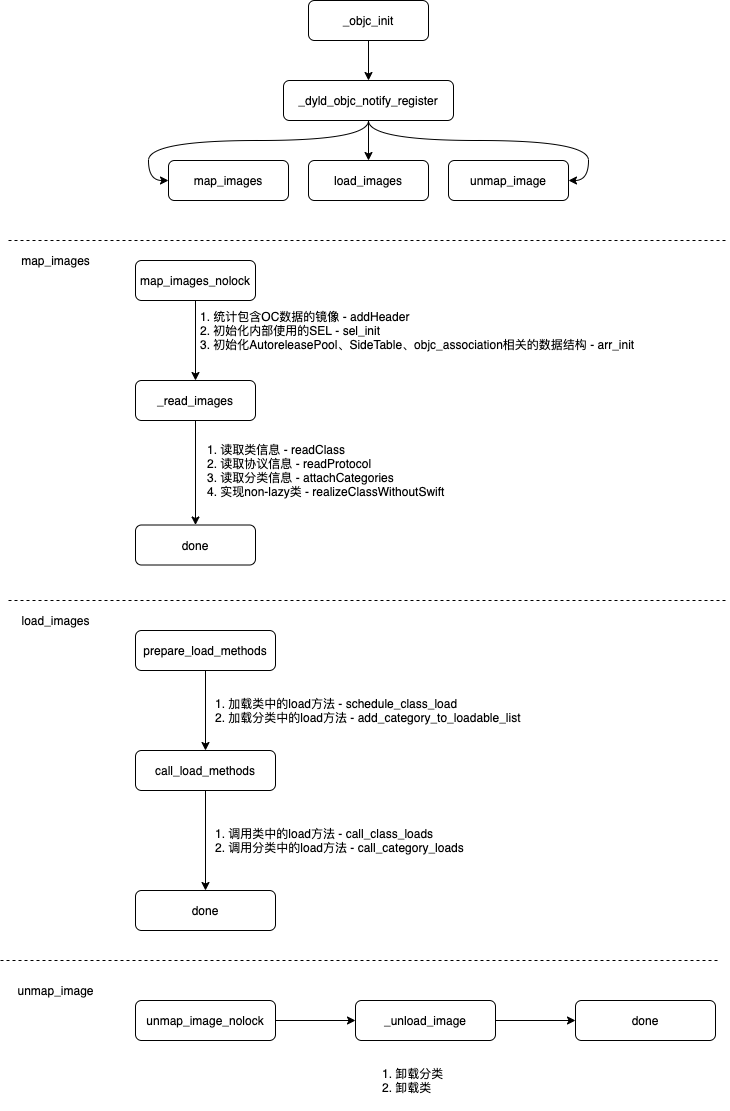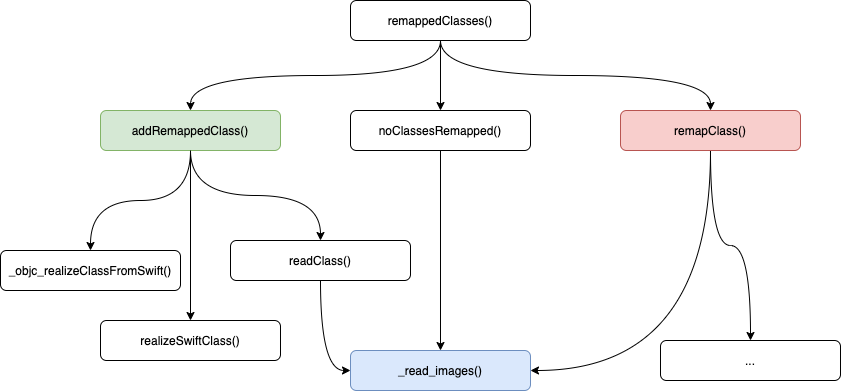起源 _objc_init
严格来说
_objc_init并不是最开始的起点,_dyld_start才是。这里暂不讨论dyld的加载。
一切要从_objc_init方法说起。_objc_init是 Objc 的初始化入口,由系统调用。这里除了必要的初始化外,向dyld注册了相关的回调,类(对象)的处理就是这些回调中进行的。
1 | |
这个函数接收 3 个函数指针,分别用于接收加载镜像、初始化镜像、卸载镜像的事件。下面是这 3 个流程的大致说明。

接下来,我们就以这三条主线来研究系统是处理如何类(对象)的。
map_images
在map_images阶段,又可以分为两个步骤:
- 准备数据:统计镜像、
SEL、Message,初始化全局数据结构 - 加载类数据:根据统计的数量加载类、分类、协议以及实现
non-lazy class
其中步骤 2 是核心。但在正式开始之前,我们需要先了解下几个相关内容:future classes、remapped classes、gdb_objc_realized_classes和nonmeta classes。这几个概念并没有详细的说明,但分析map_images又不可避免。所以下面采用顺藤摸瓜的方式探索,一起瞅瞅吧。
future class
该类型的class存储在NXMapTable类型的future_named_class_map全局变量中。根据注释,NXMapTable是一种类似字典的结构,其中key-value必须是指针或整形。下面是future_named_class_map变量的调用路径图:

初始化及基础支撑
futureNamedClasses()、haveFutureNamedClasses()、popFutureNamedClass()三个函数是直接访问future_named_class_map的,分别负责:初始化、判断是否存在future class、弹出一个future class。
数据的添加
objc_getFutureClass()调用_objc_allocateFutureClass()是向future_named_class_map中插入数据的唯一入口,但是objc_getFutureClass却没有被调用。_objc_allocateFutureClass()的实现也比较简单:
1 | |
而addFutureNamedClass()负责分配rw、ro内存并关联到类数据中。需要注意的是,此时的数据中除了rw的flag加上了future的标识,其他均没有值。
1 | |
数据的消费
future class的唯一消费者是:readClass()。该方法负责读取编译器写入的类,在读取过程中会根据类名读取future class(如果有的话),并添加到remapped_class_map或gdb_objc_realized_classes或allocatedClasses记录中。
1 | |
需要注意的是readClass()并不是每次都会调用,它需要在mustReadClasses()返回true的时候才会调用。而这一流程正是在后续的_read_images()中。
至于readClass()的其他两个调用者:_objc_realizeClassFromSwift()和objc_readClassPair()也没有调用者,无法看出其是如何使用的。
至此,future class任然是个迷,只是知道系统会在某一个合适的时机生成、然后通过 readClass 读取其信息。
remapped class
该类型的class存储在objc::LazyInitDenseMap<Class, Class>类型的remapped_class_map静态变量中。根据说明,这里主要存储两种情况下进行重映射的类:
- 现有类-已经实现的
future class键值对 - 现有类-nil 键值对,该类属于
weak-linked类型
下面参考调用路径,继续分析:

初始化
remappedClasses()函数是负责分配存储该类型class内存的,这是一个局部静态变量。
数据的添加
addRemappedClass()负责向remapped_class_map中插入一个{oldcls, newcls}键值对。
数据的消费
既然存在这样的重映射,那么对于给定一个class,可能不是最终使用的class,所以就需要一个方法去确定这个情况。remapClass()就是干这个的:
1 | |
按照上面的线索,可以知道remapped_class_map存储了那些原始类和使用类不统一的类。
gdb_objc_realized_classes & nonmeta_class_map
gdb_objc_realized_classes表存储了不在dyld共享缓存中的类,该类可能已经被实现或者没有。
nonmeta_class_map表是gdb_objc_realized_classes表的补充,只存储了一种类型的类:在主表gdb_objc_realized_classes存在,但不是因为同名因素而存在的。
这里不是很好理解,原注释是: It only contains metaclasses whose classes would be in the runtime-allocated named-class table, but are not because some other class with the same name is in that table.
这两张表也都是NXMapTable类型。不同的是,前者存储name-class键值对,后者存储了metaclass-class键值对。
下面参考其对应的调用图继续分析:


初始化
gdb_objc_realized_classes的初始化时在_read_images()函数中进行的。初始化时分配的内存为之前统计到类数量的4/3倍。而nonmeta_class_map的初始化是通过懒加载的方式进行,由其getter方法nonMetaClasses()负责。
数据的添加
addNamedClass()负责向gdb_objc_realized_classes插入一个name-class键值对,或向nonmeta_class_map中插入metaclass-class键值对:
1 | |
可以看到,在使用名称从getClassExceptSomeSwift()函数查询到class,并且和入参replacing不相等的时候,会插入到nonmeta_class_map中。再看看getClassExceptSomeSwift()函数的实现:
1 | |
这里的实现也比较简单,就是通过名称,调用getClass_impl()函数进行查找;若是Swift类名,还会多一次查找。所以getClass_impl()才是核心:
1 | |
通过上面的分析,我们知道在addNamedClass()中,一个类具体会插入到哪个表中有几种情况:
getClassExceptSomeSwift()未查找到 - 记录插入主表getClassExceptSomeSwift()查找到, 结果和入参replacing不相等 - 记录插入的附表getClassExceptSomeSwift()查找到, 结果和入参replacing相等 - 记录插入主表 在整个类初始化过程中,使用getClassExceptSomeSwift()函数查找类时,是查不到的,所以程序中多数的类会被插入到gdb_objc_realized_classes表中。
最后,对应addNamedClass()的入参replacing,我排查了对应的几个调用方,它只有 2 种可能:
nil默认值,在_objc_realizeClassFromSwift()和objc_duplicateClass()以及objc_registerClassPair过程中也传入的是nilfuture class在readClass()过程中
所以,在replacing有值时,它一定是future class。
数据的消费
类对象被添加到主表和附表中后,会在程序后续的运行中进行访问,具体细节这里先不分析。最后,在程序镜像卸载时,通过removeNamedClass()进行移除:
1 | |
综上,我们知道了,在程序中使用的类对象大多添加到了gdb_objc_realized_classes,剩下一部分会添加到nonmeta_class_map中。
_read_images
_read_images函数主要是读取镜像中的信息,包括@selector引用、类、分类、协议。依据前面讲到的内容,这里主要分析类相关的内容。
Discover classes
这里主要扫描镜像中的类列表,并通过readClass()函数将类添加到记录表中,并返回。返回值可能是nil、类本身或future class。若返回了future class,这里还会记录,后续将这种类型的类通过realizeClassWithoutSwift()函数实现。
Fix up remapped classes
在Discover classes阶段,调用readClass()可能会读取到需要进行重映射的类。这个阶段会将镜像中的类引用,修复到映射之后的值上。
1 | |
Discover categories
这里主要扫描镜像中的分类列表,然后根据类是否Realized采取不同的动作。
- 对于
Realized的类,将分类中的实例方法、实例属性添加到类对象上;将类方法、类属性添加到元类对象上(OC 居然可以添加类属性,表示没用过)。这个过程主要的功臣是attachCategories()函数。 - 对于暂未
Realized的类,只是简单的添加到unattachedCategories,后续通过methodizeClass处理。
attachCategories():
1 | |
需要注意的是,attachCategories方法是调用attachLists结构中的attachLists方法完成插入的。这个方法有个特点,在之前的文章中有提到,它会将之前的数据后移,将新的数据放置在前面。所以会导致最后加载的分类方法在列表最前面,存在同名方法按续查找会覆盖。
methodizeClass:
1 | |
Realize non-lazy class
non-lazy类型的类是指实现了load方法或者存在对应的静态变量。该阶段会扫描non-lazy类并将其实现,然后记录到allocatedClasses表中。这里的实现主要做了几件事情:
- 分配
RW内存 - 分配
class索引 - 实现当前类的父类及元类
- 确定是否使用原始
isa指针 - 初始化
isa - 修复
ivar偏移量 - 关联类与父类关系
- 关联分类
具体参考下面的代码:
1 | |
load_images
该阶段主要处理类的 load 方法。思路比较清晰,先准备,然后调用。
prepare_load_methods
准备 load 方法时,先处理类,再处理分类。在处理类的时候,会优先考虑类的父类。具体见代码:
1 | |
call_load_methods
经过上一步的 prepare,会得到loadable_classes和loadable_categories两个数组,分别存储类和分类的 load 方法信息。下面就是顺次遍历调用了:
1 | |
需要注意的是,在准备和调用时均是直接操作函数地址,并没有走 OC 的消息机制。
unmap_image
这里负责卸载不在使用的镜像。是主要包含:
- 卸载镜像
- 移除 Header 信息
其中卸载镜像时,会先移除分类,再移除类及其元类并释放相关内存。具体细节参考unmap_image_nolock和_unload_image
unmap_image_nolock:
1 | |
_unload_image:
1 | |
总结
好了,到这里可以暂时舒缓下了,一起梳理下该篇讲的内容。我们以镜像的使用周期为主线,分别探索了镜像的读取(包含类、分类以及类的实现等),镜像的加载(load 方法的扫描及调用),以及镜像的卸载。
这里还遗留了部分问题没有解决,比如:
methodizeClass主要处理了ro中的方法以及分类中的信息,其中涉及到的方法排序具体是怎么样的?non-lazy class是在_read_images中进行了实现,那其他的类是在什么时候实现的?- …
希望大家带着自己的疑问,继续前行。共勉!